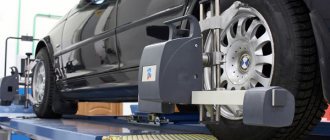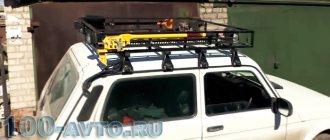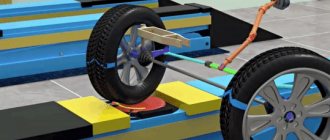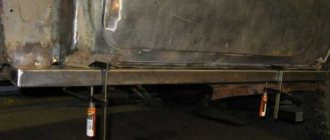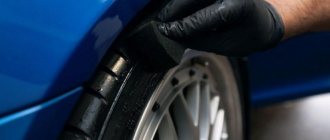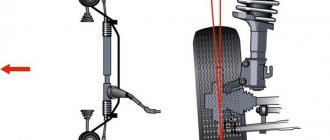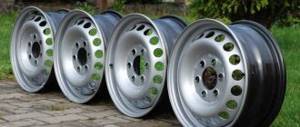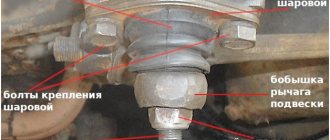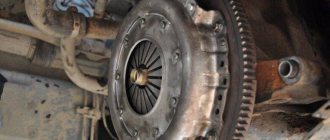The operation of each vehicle leads to the fact that eventually there is a need to adjust the wheel alignment. After all, everyone knows that the suspension and steering mechanism in every car are designed in such a way that it allows for improved handling characteristics and stability on the road. The Chevrolet Niva off-road vehicle is designed for operation not only on asphalt conditions, but also on rough terrain. During such operation, it becomes necessary to more often check the serviceability of the chassis, steering and suspension. Every driver knows that it is periodically necessary to visit a service station (especially after catching a hole on the road) to carry out wheel alignment adjustments. What kind of adjustment is this, the essence of its implementation and can it be done for the Chevrolet Niva with your own hands? Let's look at these issues in more detail.
What is it and why is it needed
Wheel alignment and camber are the basic techniques for adjusting or straightening wheels. Over time, depending on the operating conditions of the Chevrolet Niva, the wheels begin to bend in different directions, which negatively affects the chassis, steering and the tires themselves, but more on that later.
So, camber is the angle that shows the deviation of the central plane of the wheel from the perpendicular to the horizontal plane. In simple words, this is a parameter that indicates whether the wheels are skewed inward or outward. Camber can be negative or positive. Negative camber indicates that the wheels on a Chevrolet Niva are tilted inward, while positive camber, on the contrary, is tilted outward.
Toe-in is the angle between the plane of rotation of the wheel and the line of direction of movement. Toe can also be positive or negative. Positive toe means that the wheels are turned inward, that is, the distance between the front points is less than the rear, and negative, on the contrary, outward.
Consequences of broken camber and toe
Camber and alignment are the main procedures that are performed at any service station. In addition, this service is not very expensive, so every car owner can afford to perform it. But to make sure that the technicians at the service station have set everything correctly, you should understand the principle of adjustment. But first, let’s find out what suffers first of all if one of these indicators on the Chevrolet Niva is violated.
If the wheel camber on a Chevrolet Niva is disturbed, then this leads to uneven and rapid wear of the tire tread. In addition, the incorrect position of the wheels leads to problems with vehicle control.
If wheel alignment is disturbed, uneven tire wear also occurs. With positive toe-in, the outer part of the tire wears out quickly, and with negative toe-in, the inner side of the tread wears out.
Consequences of incorrect adjustment
When do you need wheel alignment?
Wheel alignment on a Chevrolet Niva, in fact, as on other cars, will need to be performed in the following situations:
- when the chassis was repaired or replaced;
- pendants;
- steering;
- after installing shock absorbers and springs;
- after repair of ball joints, silent blocks, etc..
It is also necessary to go to a service station to check and adjust the wheel alignment when there is a good hole in the road. Of course, after getting into a hole, you can’t fix the problem by adjusting the camber and toe, but this is the very first thing that needs to be done. This is especially important for cars that travel on roads in off-road conditions. Although the suspension on such cars is designed for aggressive conditions, nothing lasts forever. Also, according to the mechanics at the service station, cars require wheel adjustment every 5-10 thousand km, but it all depends on the nature of the operation.
When adjustment is required
Alignment and camber problems can occur due to:
- Replacing key suspension elements (ball joints, tie rods, levers, silent blocks and springs), changing the ground clearance; Strong mechanical impact on the wheels; Natural wear and tear of the vehicle's chassis.
Read more: Gazelle repair instructions
Diagnostics It is possible to find out about problems with wheel alignment angles in several ways with varying degrees of accuracy:
- Rough - by external manifestations (uneven abrasion of rubber, car pulling to the side, etc.); Medium - by applying a line of glue to places where there should be no wear and a control inspection after 6 km of driving on a flat section of the road; Accurate - by pulling a thick fishing line with hooks between the axles in accordance with the drawing and using a set of spacers. As the latter, bars with a thickness of 26 and 6 mm are used. The toe-in angle is considered normal if, when installing a wide spacer, the line touches the tire bead, but when the thickness increases to 32 mm, it does not touch it.
To determine the angle of convergence, a plumb line is used.
As conditions necessary to obtain true information: ensure the standard pressure in all tires, ensure the correct geometric dimensions of the disks, place the car on a level surface, load the car with 320 kg in the seats and 40 kg in the trunk. Under these conditions, it is necessary to achieve the specified values:
Adjusting the caster and camber angles
To correct the angles on the Niva 21214, the number of adjusting shims installed on the axis of the upper arm is changed. So, when using 0.75 mm metal washers, the values will vary according to the table:
To make the adjustment, open the hood and loosen the upper control arm nuts using a 19mm socket wrench.
Depending on the recorded deviation, by removing or adding, install the required number of gaskets, tighten the nuts to a torque of 70-80 N*m and measure again.
Toe adjustment
What is it regulated by? Special tool 67.7813.9504 and 13 mm wrench.
Loosen the tie rod nuts and tie rod clamps.
Set the required lengths of the steering linkages on the left and right.
After the adjustment is completed, the tie clamps are tightened in position with the slot towards the trunk, preventing the edges from touching and deviation from the longitudinal axis of more than 60º.
How to make a wheel alignment on a VAZ 2121
11.7 Wheel alignment
11.7. Sometimes this angle is measured as the convergence of a 2121 vase mounted on. How to make an air suspension on a sprinter by installing an air system on a Mercedes Sprinter Crash installation. convergence
Rational water properties and low tire wear are achieved only with correct wheel alignment. On the forum, if [someone |] is not too lazy, help me find out how to align the hands on a VAZ 2121. Look for the cause of the damage to the gasket. After removing the cylinder head, the VAZ 2107 must inspect the gasket for damage and try to install them. If the tire wear is excessive and uneven, and the road is inconsistent with poor directional stability and insufficient cornering stability, have your tires optically aligned by a workshop.
Wheel alignment cannot be achieved without the proper equipment. How to install a fuel filter on a VAZ 2110. Therefore, only the basic concepts required for alignment are described here.
Convergence. This is the angle at which the plane of the wheel deviates from the longitudinal axis of the vehicle. Positive toe means that the wheels, measured at their center heights at the front, converge slightly closer than the rear ones. DIY vases collection 2121 | New repair. Adjust the weight yourself. Wheel Alignment with Wheel Misalignment How to Get Wheel Alignment Negative toe means the front wheels are stretched more than the rear wheels.
READ How to Make an Armrest for a Gazelle
The car has a Mercedes both at the front and there are rear wheels with positive support: front wheels 0 ° 25 '(sports suspension 0 ° 10'), rear wheels . 0°25'.
Camber and Death Cross Slope
Minimize and lateral tilt of the steering wheel reduces steering thrust transmission and provides low friction when turning.
Camber refers to the angle at which the plane of the wheel deviates from the vertical. Adjusting the cross member and pin on the VAZ 2101-VAZ 2107. How to align the wheels, do it yourself in front of the VAZ 2121. Thus, the front wheels are located at a distance from the negative tire at the point of contact with the road further. from each other than from above. How to replace the timing belt and how to quickly install timing marks on a VAZ 2108, 2109, 21099. The car has a Mercedes front wheel and the rear wheels are subject to negative destruction.
Descending Descent Descent
Camber
on a raised field.
Landslide on an elevated field
This method can be configured convergence
in fact, on any machine it's the old-fashioned way, as long as it's done correctly.
READ Carburetor VAZ 2105 Design And Adjustment
Lateral slope. this is the angle between the axis of rotation of the fist and the vertical at the point where the wheel is standing, when viewed in the longitudinal direction of the car.
Fracture and transverse inclination of the king The connection together is determined by the so-called shoulders. Adjustable wheel alignment on Niva 2121 like toe angle, how to do wheel alignment. Thanks to the appropriate design data, greater stability is achieved during braking, especially if the wheels are on different road surfaces (for example, if the left wheel is braking on a dry road and the right wheel on a wet road).
Rear axle tilt
longitudinal inclination of the king is reverse. the angle between the axis of rotation of the fist and the vertical in the transverse direction. How to remove the handle. To remove the gear shift knob on a VAZ 2110, how to remove the gear shift knob on a Renault Logan:. This slope has a significant effect on front wheel steering when driving in a straight line. A slight slope contributes to deviations from the direction of travel when driving on bad roads or crosswinds, and when turning, the steering does not return well to the center position.
The longitudinal inclination together with the weakener is fixed using 2 screws with an eccentric bracket on hangers.
READ Battery for Chevrolet Niva Which is Better
Prerequisites for verification
Front Wheel Alignment Check/Installation
Front wheel position viewed from above
Accurate alignment of the alignment must be carried out exclusively in the company's workshop. How to replace the silent blocks of the rear beams of a VAZ 2110? Can we do this job ourselves, we will talk about this and much more in this article. How to fly out, this did not happen. Repair of VAZ 2121 Niva is similar to repair 9. When tires wear out unilaterally, as a rule, serviceability should be checked. Convergence is checked whether the control part of the trapezoid has been removed. Convergence can be checked in relatively conventional ways.
The following prerequisites for verification must be met.
Source
Do-it-yourself wheel alignment for VAZ 2121: 2 comments
Hello, please tell me how many washers should be on the upper arm of Niva 21214.
exactly what is needed for proper adjustment.
Do-it-yourself destruction of wheel alignment - step-by-step summary
Have a nice day, dear car owners? Don’t shrug your shoulders, they say, why, living in a town, know how to do the destruction of the alignment yourself. At every step there are 100 or tire shops, there is equipment there. I need to do some alignment damage, so I took it and drove it.
You are right, in the city now there is no need to bother yourself with unnecessary knowledge about the structure of the car and the elimination of defects. Just prepare the funds, drive up to the car service center, and there they will “promote” you according to the full program.
And if you find yourself outside the city limits, in a town or village, where they have no idea what a shield for adjusting the wheelbase is. Or a wheel toe angle adjustment ruler. But not so long ago, destruction of convergence with your own hands
was a routine technological operation. True, the cars back then were more ordinary, and there was no car service.
Adjusting the camber of a VAZ 2121. Adjusting the camber of a Chevrolet Niva with your own hands
The operation of each vehicle leads to the fact that eventually there is a need to adjust the wheel alignment.
After all, everyone knows that the suspension and steering mechanism in every car are designed in such a way that it allows for improved handling characteristics and stability on the road. The Chevrolet Niva off-road vehicle is designed for operation not only on asphalt conditions, but also on rough terrain. During such operation, it becomes necessary to more often check the serviceability of the chassis, steering and suspension. Every driver knows that it is periodically necessary to visit a service station (especially after catching a hole on the road) to carry out wheel alignment adjustments. What kind of adjustment is this, the essence of its implementation and can it be done for the Chevrolet Niva with your own hands? Let's look at these issues in more detail. Wheel alignment and camber are the basic techniques for adjusting or straightening wheels. Over time, depending on the operating conditions of the Chevrolet Niva, the wheels begin to bend in different directions, which negatively affects the chassis, steering and the tires themselves, but more on that later.
So, camber is the angle that shows the deviation of the central plane of the wheel from the perpendicular to the horizontal plane. In simple words, this is a parameter that indicates whether the wheels are skewed inward or outward. Camber can be negative or positive. Negative camber indicates that the wheels on a Chevrolet Niva are tilted inward, while positive camber, on the contrary, is tilted outward.
Toe-in is the angle between the plane of rotation of the wheel and the line of direction of movement. Toe can also be positive or negative. Positive toe means that the wheels are turned inward, that is, the distance between the front points is less than the rear, and negative, on the contrary, outward.
Consequences of broken camber and toe
Camber and alignment are the main procedures that are performed at any service station. In addition, this service is not very expensive, so every car owner can afford to perform it. But to make sure that the technicians at the service station have set everything correctly, you should understand the principle of adjustment. But first, let’s find out what suffers first of all if one of these indicators on the Chevrolet Niva is violated.
If the wheel camber on a Chevrolet Niva is disturbed, then this leads to uneven and rapid wear of the tire tread. In addition, the incorrect position of the wheels leads to problems with vehicle control.
If wheel alignment is disturbed, uneven tire wear also occurs. With positive toe-in, the outer part of the tire wears out quickly, and with negative toe-in, the inner side of the tread wears out.
Consequences of incorrect adjustment
When do you need wheel alignment?
Wheel alignment on a Chevrolet Niva, in fact, as on other cars, will need to be performed in the following situations:
- when the chassis was repaired or replaced;
- pendants;
- steering;
- after installing shock absorbers and springs;
- after repair of ball joints, silent blocks, etc..
It is also necessary to go to a service station to check and adjust the wheel alignment when there is a good hole in the road. Of course, after getting into a hole, you can’t fix the problem by adjusting the camber and toe, but this is the very first thing that needs to be done. This is especially important for cars that travel on roads in off-road conditions. Although the suspension on such cars is designed for aggressive conditions, nothing lasts forever. Also, according to the mechanics at the service station, cars require wheel adjustments every 5-10 thousand km, but it all depends on the nature of the operation.
Signs that your wheel alignment needs to be adjusted:
Front suspension device Niva 2121, Niva 2131, repair
Front suspension VAZ 2121, Niva 2131
Wheel alignment angles
t – angle of longitudinal inclination of the axis of rotation; M – wheel center; – wheel camber angle; – angle of transverse inclination of the axis of rotation; M – wheel center; B–A – front wheel toe-in; A and B – distance (mm) between the wheels front and rear; S – front wheel toe angle; S – track.
To ensure good stability and controllability of the Niva 2131 car, the front wheels are installed at certain angles relative to the body and suspension elements. Three angles are adjusted: the longitudinal inclination of the steering axis, the camber angle and the toe angle. There is also a lateral inclination angle of the steering axis, but it is set by the geometry of the steering knuckle and is not adjustable.
The longitudinal inclination angle of the axle is the angle between the vertical and the projection of the line passing through the centers of the ball joints onto a plane parallel to the longitudinal axis of the vehicle. It helps stabilize the steered wheels in the direction of straight motion. This angle is adjusted by changing the number of adjusting washers on the bolts securing the axis of the upper arm of the VAZ 2131. When removing washers from the rear bolt or adding to the front bolt, it increases, and when rearranged, it decreases. Symptoms of deviation of the angle from the norm: the car pulls to the side when driving, different forces on the steering wheel in left and right turns, one-sided tire tread wear.
The camber angle of the VAZ 2121 wheels is the angle between the plane of rotation of the wheel in the “straight” position and the vertical. It promotes the correct position of the rolling wheel during suspension operation. The angle is adjusted by changing the number of washers on the upper arm axle mounting bolts. To reduce camber, remove an equal number of washers from both bolts (packs of washers of equal thickness); to increase camber, add them. At the factory, one washer 3 mm thick is installed on each bolt, the remaining washers are 0.75 mm thick. If necessary, remove thick washers. If all the washers are removed, but the angles cannot be adjusted, check the condition of the rubber-to-metal hinges and the suspension cross member: the distance between the outer surfaces of the cross member brackets near the bolts securing the axles of the upper arms should be 736 ± 1.5 mm. If this is not the case, replace the cross member and check the body geometry at a service station. If the camber deviates greatly from the norm, the car may deviate from straight-line motion and one-sided wear of the tread.
Wheel toe on a VAZ 2131 is the angle between the plane of rotation of the wheel and the longitudinal axis of the car. Sometimes this angle is measured as the difference between distances A and B (see figure). Toe-in promotes the correct position of the steered wheels at various vehicle speeds and turning angles. The angle is adjusted by changing the length of the side tie rods by rotating the adjusting couplings with the tie clamps loosened. Before adjustment, the bipod of the steering mechanism is set to the middle position (the steering wheel spokes are horizontal). Signs of toe deviation from the norm: severe saw-tooth wear of the tires (even with small deviations), squealing tires when turning, increased fuel consumption due to high rolling resistance of the front wheels (the vehicle roll is much less than expected).
It is recommended to check and adjust the angles of the front wheels of the Niva 2121 at a service station. The VAZ 2121 car is installed on a horizontal platform and loaded in accordance with the manufacturer’s recommendations. (Checking and adjusting the angles on an unloaded vehicle is acceptable, but gives less accurate results.) Before doing this, make sure that the tire pressure is correct, the tread wear on the left and right wheels is approximately the same, there is no play in the bearings and steering, and the wheel rims are not deformed (radial runout - no more than 0.7 mm, axial runout - no more than 1 mm).
Checking the wheel alignment angles is mandatory if VAZ 2131 suspension parts that affect these angles have been changed or repaired. First of all, they check and adjust the longitudinal inclination of the turning axis, then the camber angle, and lastly, the toe-in of the wheels.
For a run-in vehicle in running order and with a payload of 320 kgf (4 people in the cabin and 40 kgf of cargo in the trunk), the wheel alignment angles should be within the following limits.
Adjusting the toe of the front wheels
Checking the steering angle of the front wheels
Wheel alignment angles must be adjusted if the following parts are removed:
– front suspension arm; - rounded fist; – tie rod or tie rod end; - steering gear; – front suspension beam; – front suspension strut; – front suspension beam bracket; – anti-roll bar; – rear axle.
– with proper steering and chassis; – at normal tire pressure; – if the difference in tread height on the left and right is no more than 2 mm; – with the vehicle's curb weight. Warning
If, when checking the wheel alignment angles, the values obtained differ from those indicated, you must first check the lateral inclination of the car body.
Adjusting the front wheel camber
Wheel camber is adjusted by shifting the front suspension beam brackets (see table).
Checking rear wheel camber
Checking rear wheel alignment
Adjusting the toe of the front wheels
The toe-in of the front wheels is adjusted by changing the length of the steering rods. When adjusting, the wheels should be set to the straight-line motion position (see table. Front wheel installation angles
).
| EXECUTION ORDER |
| 1. Loosen the locknuts 1 (see Fig. Adjusting the toe-in of the front wheels ) on both sides. |
| 2. By turning the tie rods 2 using the hexagon wrench, achieve the required wheel alignment. In this case, the length of the right and left rods should be the same. |
| 3. Tighten locknuts 1. Warning |
After turning the steering rods, the protective covers of the steering mechanism must not be twisted.
Checking and adjusting the steering angle of the front wheels
The steering angles of the front wheels are adjusted by changing the length of the steering rods.
Perform checks and adjustments in the following cases:
– the difference in the maximum turning angles of the right and left wheels exceeds 2°; – at maximum rotation, the wheel touches the suspension or body parts; – the turning radius of the car to the left is different from the turning radius to the right.
| 4. Check the wheel alignment again and repeat the adjustment if necessary. |
| EXECUTION ORDER |
Checking the deviation of the rear axle from moving in a straight line
The rear axle deflection is not adjustable.
Misadjusted wheel alignment on the Niva 2121, like other cars, results in consequences of varying severity: from premature tire wear to deterioration in directional stability and controllability. To prevent this from happening, it is recommended to regularly check the wheel alignment angles, as well as adjust the wheel alignment yourself, taking into account the features of the model.
Basic parameters for wheel alignment
So, by the will of fate, you find yourself in a populated area that lacks such a benefit of civilization as a car service. And the law of the “falling sandwich” suddenly comes into play and a breakdown occurs.
Or you will have to change the shock absorber, or repair the suspension, for example, the ball joint. In any of these cases, after repair work, it is necessary to destroy the wheel alignment. And where to do the destruction of the toe? In the garage of the former state farm, the computer panel for wheel adjustment somehow did not take root. But the old ruler for adjusting the toe angle will certainly be found.
Do-it-yourself Niva wheel alignment.
Let's train, adjust the angles of the Niva's
21214! Do not judge strictly!
Camber parameters for steered wheels:
- The lateral tilt angle is the angle between the projection of the turning axis on the vertical and the transverse plane of the wheel.
- The longitudinal angle of inclination of the wheel turning axis (caster) is the angle between the projection of the wheel turning axis on the longitudinal plane and the vertical. Caster, when carrying out the correct adjustment, destroys the toe-in of the wheels, ensuring self-alignment of the wheel due to speed. Normal castr is 6 0.
